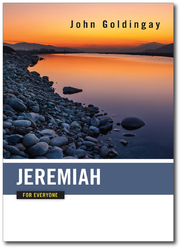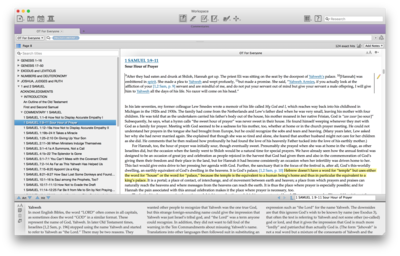Daily readings of the Bible have a long history in Jewish and Christian traditions. We even facilitate daily readings in Accordance if you want to practice this discipline digitally. Many daily reading plans of the Bible seek to have the reader complete the Scriptures in a year, and some aim for an even shorter time period. I sometimes wonder, “What’s the rush?”
Of course, there’s a difference between reading the Bible and studying the Bible. The latter takes a bit more effort and goes at a slower pace. Few will have the time to study (let alone reflect and act on) the entire Bible in a year. In the 1950s, William Barclay released a series of New Testament commentaries aimed at the “ordinary reader.” Although the series was titled The Daily Study Bible, it was not a study Bible in the sense of what we think of today. It was not a thick Bible with commentary at the bottom of the page. Rather, it would become 17 volumes of Barclay’s own translation and commentary of the New Testament, divided into short enough segments so that each could be studied in one sitting. Barclay’s work is known for its accessibility through explanation of key original language words and memorable stories and illustrations. This series is available in Accordance as The New Daily Study Bible.
 Although N. T. Wright never mentions Barclay or The New Daily Study Bible in his series, The New Testament for Everyone, when I saw it, reminded me immediately of the pattern: Wright’s own translation and commentary, broken into short segments, with explanations and stories aimed at the “average” modern reader. Having had the two previously mentioned series in Accordance for some time, today we are releasing the companion to Wright’s series with John Goldingay’s The Old Testament for Everyone.
Although N. T. Wright never mentions Barclay or The New Daily Study Bible in his series, The New Testament for Everyone, when I saw it, reminded me immediately of the pattern: Wright’s own translation and commentary, broken into short segments, with explanations and stories aimed at the “average” modern reader. Having had the two previously mentioned series in Accordance for some time, today we are releasing the companion to Wright’s series with John Goldingay’s The Old Testament for Everyone.
Next Sunday, I am teaching on verses from 1 Samuel 1 at my church, so I was naturally interested in what Goldingay had to say about the passage in The Old Testament for Everyone. I should point out that Goldingay breaks ch. 1 into five separate readings. Remember what I said about going at a slower pace when studying the Bible as opposed to just reading it? Five days in 1 Samuel 1 is a healthy pace in my opinion.
Click/tap the image above for a larger view of The Old Testament for Everyone.
Goldingay’s approach to Hannah’s anguish (which Goldingay described as “fretful in the sense of offended and angry”) was one that attempts to offer more empathy than either her husband Elkanah or high priest Eli gave her. Goldingay is both personal and contemporary in his approach. Of Elkanah, he comments,
So Elkanah finds himself living with permanent tension in the household and with deep depression in the soul of the woman he loved first and best. The poor man does his best to handle the situation, but we guys are clueless about understanding women. “Am I not better to you than ten sons?” Actually, Elkanah, no. Don’t apply a Band-Aid to the wound. Get her to talk about it some more.
And after Eli realizes that Hannah’s prayer at the Tabernacle is not the result of having had one too many, he knows that he has to respond to her “pastorally.” Goldingay writes,
Eli desperately tries to regroup and remember what they told him in seminary about dealing with distraught and angry women, and he manages to get his act together. Various stories in the Old Testament illustrate the dynamics of prayer in this connection, and this is an example. As the word pleading suggests, when the Old Testament refers to prayer it doesn’t have in mind something like meditation or reflection, something designed to change us. Prayer is something more like the relationship of a child to its father or mother. When a child is hurt or scared, it comes to its parents to get them to do something about it, and (hopefully) they assure the child that they will. Eli knows that his job as a pastor in this connection is to bring God’s response to Hannah’s prayer.
I appreciated Goldingay’s wording above. Obviously, Eli didn’t go to seminary as in the modern sense, but using dry humor, Goldingay is making connections for the reader between the ancient world and the modern.
Each section of The Old Testament for Everyone can be studied in one sitting. The translation is Goldingay’s own. He uses the context of the commentary “to stick closer to the Hebrew than modern translations often do when they are designed for reading in church” (Genesis 1-16, “Acknowledgements”). This translation method includes using Yahweh for the divine name instead of the traditional “Lord.” This name–along with other significant words such as peace, Israel, Philistines, covenant, and many more–are hyperlinked throughout the commentary. These hyperlinks connect the reader to more detailed explanations that can be viewed easily in Instant Details or by clicking and going to that point of the text.
NOTE: Currently, the Accordance edition of The Old Testament for Everyone contains 15 volumes but lacks Lamentations-Ezekiel (vol. 16) and Daniel-Malachi (vol. 17). However, we expect to add them within three months at no additional charge, and these final installments will complete the set.
Update: 9/1/16 these two volumes were added in the free update to version 2.0 of the module.
Why not begin in Genesis now (you’ll have plenty of time before getting to Lamentations!) and study your way through the Bible as opposed to simply reading through it. Studying the Bible will take you longer, but the benefits will be greater, too. Afterwards, you can transition right into N. T. Wright’s New Testament for Everyone!


